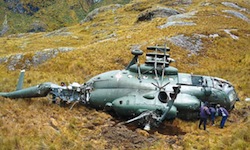IDL-Reporteros looks at the casualties suffered during Peru’s guerrilla conflict in the so-called VRAEM region over a 30-year period, highlighting changing strategies, as well as successes and setbacks, in relation to the number of fallen soldiers and police.
This investigation began at the end of 2013. Esteban Valle Riestra, an IDL-Reporteros collaborator, proposed the idea of exploring what information could be gleaned from the registry of casualties suffered by the armed forces and the national police during the conflict in the Apurimac, Ene and Mantaro River Valleys (VRAEM).
The VRAEM is the only region in Peru where the Shining Path’s armed insurgency, unleashed in 1980, has continued without interruption. It is, for this reason, the region with the highest concentration of security forces in the country.
It is also the epicenter of drug trafficking in Peru. From the VRAEM, dozens of drug planes take off every week, with almost total impunity.
*This article originally appeared in IDL-Reporteros and has been translated, edited and reprinted with permission. See original here.
In this complex scenario, arriving at a clear diagnosis of what has happened over time in that region isn’t easy. What works and what doesn’t? Which events have most clearly impacted the conflict?
“War metrics” help to dispel the proverbial fog of war, which in irregular conflicts makes it particularly difficult to appreciate the strategic horizon.
SEE ALSO: Peru News and Profiles
And after a long and tedious effort to obtain and verify the numbers, the casualties were organized by when and where they occurred, in both time and space. This is the interactive information that you can see both in the war metrics map and in the timeline.
What does the map indicate? Several things, but these are the most important:
- The intensity and importance of the conflict varies significantly within the VRAEM territory.
- The area where the most important battles and deadliest ambushes took place, and where the most significant blows were dealt to the Shining Path, is relatively small.
- The worst ambushes and the most successful operations occurred in nearby areas but at very different times. In the interim, the area widened and then narrowed again. The relationship between causes and effects is clearer in the timeline.
The interactive infographic on the timeline of the VRAEM conflict contains a lot of information. The main points are the following:
- Counterinsurgency operations in the VRAEM started in a systematic form during the government of former President Alan Garcia. Before and during former President Alejandro Toledo’s administration, there were sporadic and limited operations with generally negative outcomes.
- The first stage of the armed forces and national police counterinsurgency against the VRAEM faction of the Shining Path began in August 2008 with Operation Excellence 777. This stage, which began with the takeover of the Bidon base and the stronghold of Vizcatan, was predicated on an effort to obtain territorial control through military bases and patrols. During this phase, after a short Shining Path retreat, security forces suffered some of their serious setbacks such as the ambushes of Tintay Puncu and Sanabamba, and the downing of a helicopter in Sinaycocha. The Shining Path was able to expand towards La Convencion and was also able to recover Vizcatan and Bidon after both were abandoned by the armed forces.
- This stage lasted, grosso modo, until 2012. It was a fundamentally military territorial counterinsurgency effort that failed.
- In February 2012, the Shining Path leader “Artemio” (see photo below) was captured in Huallaga thanks to the successful use of both technological and human intelligence methods followed by prompt military (or police) action.
- The government adapted these methods, from A to Z (and beyond) to the VRAEM. It united the national police intelligence units with the Joint Command Special Forces and placed these security forces under the coordination of the Vice Minister (Ivan Vega), who has direct access to President Ollanta Humala, to achieve efficient coordination with the armed forces. Security forces moved from the fight for territorial control to the strategy of targeting, above all, to the so-called “High Value Targets” of the Shining Path.
SEE ALSO: Shining Path Profile
- The shift from the military counterinsurgency stage to the stage of selective targeting gained momentum starting in mid-2012. Its main results were the deaths of three of the most prominent Shining Path leaders: “William,” in September 2012, and “Alipio” and “Gabriel” in September 2013.
- The almost total retreat of the Shining Path VRAEM faction, starting in September 2013, was reflected in the large decrease in military casualties. The previous expansion of the Shining Path transformed into withdrawal, weakness, and loss of influence.
- However, recent actions indicate that the retreat may be over, and that the Shining Path is cautiously trying to carry out guerrilla actions while shielding itself from its mostly technical vulnerabilities.

The casualties security forces suffered in the VRAEM don’t just express, in numbers, the tragedy of lives lost or people wounded in this conflict. Their sacrifice also provides important information.
The following infographics illustrate the casualties by regions, by presidential administration, by institution, and in relation to the deadliest ambushes.

